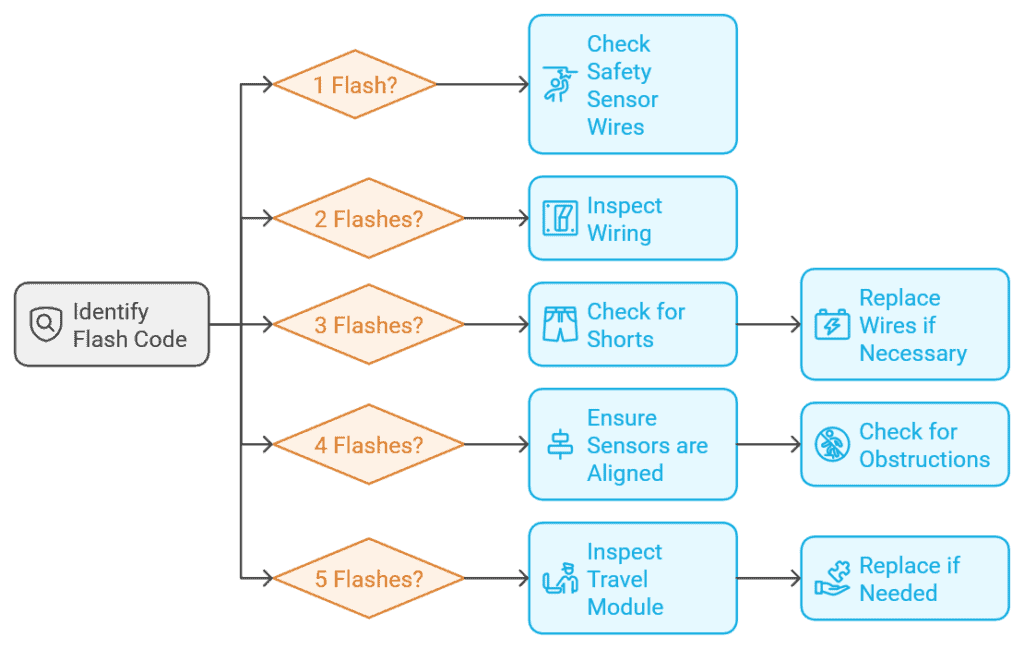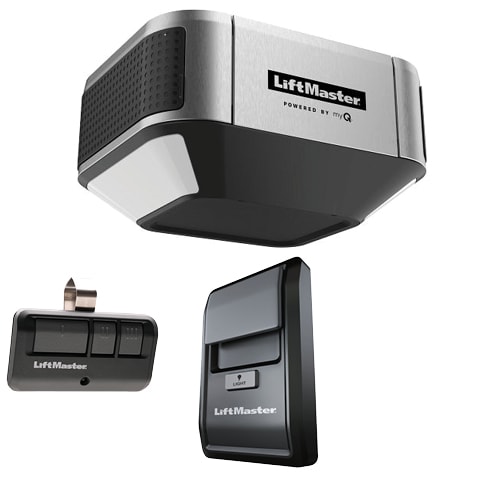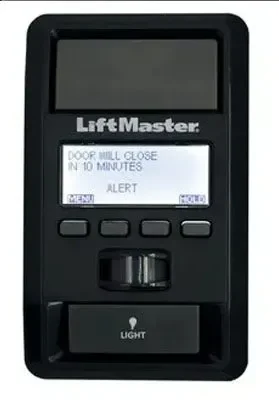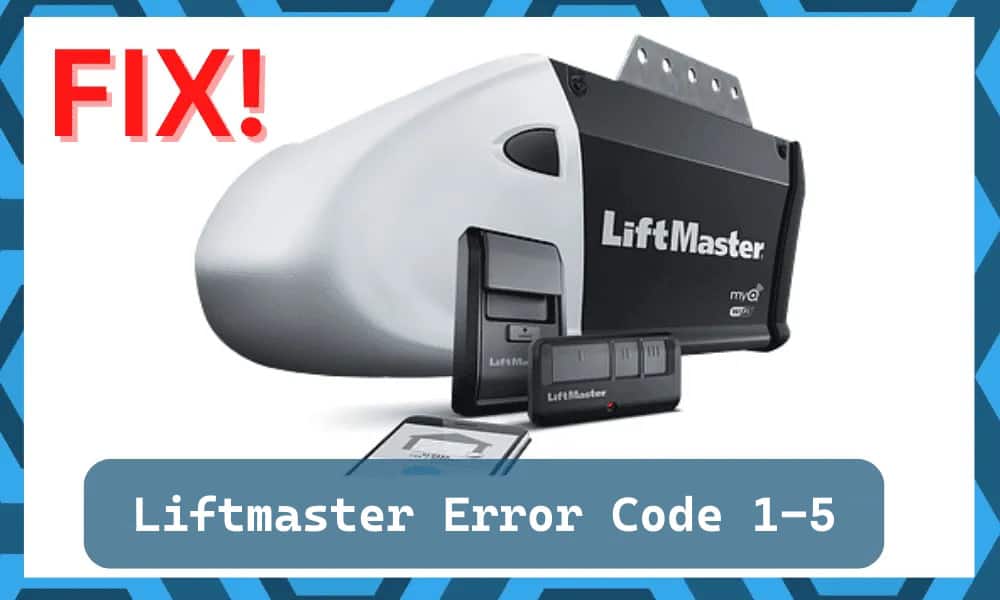In the world of garage door openers, LiftMaster stands tall as one of the most trusted brands. However, even the most reliable machinery can encounter hiccups along the way. If you find your LiftMaster garage door opener throwing error codes at you, fear not! We’re here to guide you through decoding these cryptic messages and getting your garage door back in action.
Understanding Liftmaster Error Code 1-5
So, what exactly is LiftMaster error code 1-5? This error message indicates a malfunction in your garage door opener system. Whether you own a LiftMaster or Chamberlain garage door opener, encountering this error can be frustrating. But fear not, we’re here to help you troubleshoot and resolve the issue swiftly.
Common Causes of LiftMaster Error Code 1-5
Let’s pinpoint the potential culprits behind this error code:
| Issue | Possible Causes |
|---|---|
| Garage door moves a little and stops | Binding garage door, obstructions, worn components (rollers, springs, hinges, tracks), or loose wiring. |
| Opener makes clicking sound, but door doesn’t move | Overheated motor, loose or broken parts, structural wear, or defective transformer. |
| Opener hums or buzzes, but door remains stationary | Defective motor or capacitor, structural wear, or imbalanced door. |
Liftmaster Error Codes

| UP | DOWN | PROBLEM | REASON | SOLUTION |
| 1 Flash | 1 Flashes | Garage door opener is not closing | Safety sensor wires may be faulty or sensors not installed or connected | Check for disconnected wires sensor wires. If the amber LED that is connected to the sending sensor is not lit, inspect the wire and connections to the sensor. If the LED is lit on the sending sensor, the wire connections to the green receiving sensor should be checked. If disconnected or cut, reattach the wire or replace it. |
| 1 Flash | 2 Flashes | The garage door opener will not close and the light(s) flash | Safety sensor wire shorted or reversed | Check the wiring to ensure it is not pinched or incorrectly attached. If the amber LED is not lit on the sanding sensor, inspect the wiring leading to and from the sensor. If the sending sensor LED is lit, inspect the wiring leading to the green receiving LED. And reattach or replace as necessary. |
| 1 Flash | 3 Flashes | Wall-mounted door control not functioning | Door control wires shorted or the door control is faulty | Check the wiring to the door control to see if there is a short, (staple in the wire). Replace it with a 22-gauge wire if necessary. Once new dog control wires are installed, if the door control still malfunctions, you will need to replace the door control. |
| 1 Flash | 4 Flashes | The garage door will not close and light(s) are flashing | Safety sensors are misaligned or obstructed | Check the green LED on the receiving sensor to make sure that it is not flickering. Flickering means that the safety sensor is misaligned. Check the area immediately surrounding the safety sensor to ensure that nothing is obstructing the sensors’ path and preventing the garage door from closing. |
| 1 Flash | 5 Flashes | The garage door opener clicks in response to remote but does not more The opener closes partially then stops and/or reverses |
Travel module communication error | Disconnect the garage door opener from its power source, remove the cover and find the travel module. Inspect the wires to ensure that they are connected properly. If everything is connected correctly, you will need to replace the travel module. |

How to Fix LiftMaster Error Code 1-5
Now that we’ve identified the potential issues, let’s explore how to tackle them head-on:
1. Garage Door Moves 3-6 Inches and Stops
- Troubleshooting Steps:
- Disengage the opener and operate the door manually.
- Check for obstructions and worn components.
- Inspect wiring and connections.
- Potential Solutions:
- Replace travel module if programming limits fails.
- Consider motherboard replacement if settings aren’t retained.
2. Opener Makes Clicking Sound, Door Doesn’t Move
- Troubleshooting Steps:
- Wait for motor to cool down.
- Inspect door for loose or broken parts.
- Test opener without door engagement.
- Potential Solutions:
- Replace motherboard if clicking persists.
- Address defective transformer if applicable.
3. Opener Hums or Buzzes, Door Remains Stationary

- Troubleshooting Steps:
- Test door balance and inspect for wear.
- Check opener functionality without door engagement.
- Potential Solutions:
- Replace defective motor or capacitor.
- Address any structural wear or imbalances.
Repair or Replace?
The decision to repair or replace your garage door opener hinges on various factors, including the extent of the malfunction and your expectations. While some issues can be resolved swiftly, others may necessitate more extensive repairs or even replacement. Here’s a breakdown:
- Cost of Repair: Certified repair services typically range from $400 to $1000.
- Cost of Replacement: Installing a new garage door opener can cost anywhere from $750 to $3000.
DIY vs. Professional Help
Before reaching for the phone to call a professional, consider taking matters into your own hands. Many error code 1-5 issues can be addressed with some DIY troubleshooting. However, for complex or persistent problems, it’s advisable to seek the expertise of a licensed garage door repair company.
Customer Experience: Fixing LiftMaster Error Code 1-5
To shed light on real-life experiences, let’s delve into a customer feedback scenario:
- A homeowner encountered error code 1-5 and received a hefty quote for replacement parts.
- After self-research and adjustment of spring tension, the issue was resolved without costly repairs.
Key Takeaway:
Empower yourself with knowledge and DIY troubleshooting techniques to tackle common garage door opener issues effectively.
Also read: Samsung Washer error codes
Frequently Asked Questions
- Q: How do I reset my Liftmaster garage door opener? A: Refer to your owner’s manual for specific reset instructions. Typically, you can reset the opener by unplugging it from the power source for a few minutes and then plugging it back in.
- Q: Can I replace Liftmaster garage door opener parts myself? A: Simple tasks like replacing batteries or realigning sensors can often be done DIY. However, for complex repairs or part replacements, it’s best to consult a professional technician.
- Q: Why is my garage door opener making strange noises? A: Strange noises could indicate issues with the motor, drive mechanism, or other components. Inspect the opener for any visible signs of damage and consider professional inspection if the noise persists.
- Q: How often should I lubricate my garage door opener? A: Lubrication intervals may vary depending on usage and environmental factors. As a general rule, it’s recommended to lubricate moving parts every six months to ensure smooth operation.
- Q: Can I use my Liftmaster garage door opener during a power outage? A: Liftmaster openers equipped with battery backup can still operate during power outages. Ensure your opener is properly configured and maintained for backup power usage.
- Q: What should I do if my garage door reverses unexpectedly? A: Check for obstructions in the door’s path and ensure that the safety sensors are properly aligned and free from debris.
- Q: Are Liftmaster garage door openers compatible with smart home systems? A: Yes, Liftmaster offers integration with various smart home platforms, allowing you to control your garage door remotely using your smartphone or voice commands.
- Q: How can I improve the security of my Liftmaster garage door opener? A: Consider enabling security features such as rolling code technology and ensuring that your opener’s access codes are not easily guessable.
- Q: What maintenance tasks should I perform regularly on my garage door opener? A: Regular maintenance tasks include lubricating moving parts, inspecting and tightening hardware, and testing the safety features of the opener.
- Q: How do I troubleshoot Liftmaster garage door opener keypad issues? A: Ensure that the keypad is securely mounted and free from damage. Check the battery and replace it if necessary. Realign the keypad with the opener following the manufacturer’s instructions.
Conclusion
Encountering error code 1-5 on your garage door opener can be a hassle, but with the right knowledge and troubleshooting steps, you can tackle the issue effectively. Remember to prioritize safety and consult professional help when needed. Here’s to hassle-free garage door operation!








3 thoughts on “Fix Liftmaster Error Code 1-5”